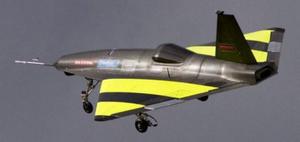UAV updateBreakthrough: Flapless UAV gets airborne
The conventional control surfaces of a UAV include many moving parts, require frequent, costly repairs, and account for a significant percentage of an aircraft’s noise output; British researchers developed a UAV with no moveable control surfaces — no flaps, ailerons, elevators, or spoilers; just a wing, an engine, and some holes

DEMON UAV during testing // Source: metro.co.uk
To make an aircraft fly and maneuver safely without the use of conventional control surfaces is an achievement in itself; to do that while at the same time bringing together new construction techniques and new control mechanisms could be said to be over-ambitious — but a British team of researchers has done just that. An unmanned air vehicle (UAV) showcasing a wide range of new technologies has successfully demonstrated “flapless flight” in the United Kingdom.
The UAV, called DEMON, made the historic flight (see YouTube video) from an airfield at Walney Island in Cumbria recently. Developed by Cranfield University, BAE Systems, and nine other U.K. universities, DEMON represents the first alternative to the moving flap technology used since the early days of aviation, in which moving mechanical elevators and ailerons control the aircraft’s flight. Conventional control surfaces’ many moving parts require frequent, costly repairs and account for a significant percentage of an aircraft’s noise output.
The Financial Express reports that BAE Systems has offered to work with Defense Research and Development Organization (DRDO) and other agencies to help India develop its autonomous UAV technology. Responding to a request for proposal for unmanned combat aerial vehicles, BAE Systems made this offer on UAV technology and collaboration to help India develop their own cutting edge capabilities.
What is important about the British breakthrough? Aviation analysts say that the British machine has no moveable control surfaces. “That’s right, no flaps, ailerons, elevators or spoilers. Just a wing, an engine and some holes. First of all, the exhaust nozzle is moveable, so it can be vectored around to aid in directional control. Also, bleed air from an APU (auxiliary power unit, meaning a small engine) is blown through hundreds of tiny holes in the trailing edge of the wing to also help with directional control.”
The military likes this because moveable surfaces like slots and flaps have edges and gaps, which are easily detectable heat-scores when you are trying to have a low radar profile. Fewer edges to bounce off mean more stealth, and this is what defense researchers are going for when they build a small UAV, most of which are used to spy on people in some way. “The advantages to this in a civilian application would be less moving parts, a stronger wing, less maintenance requirements and a cleaner wing which results in less drag, meaning less fuel burn. You could
